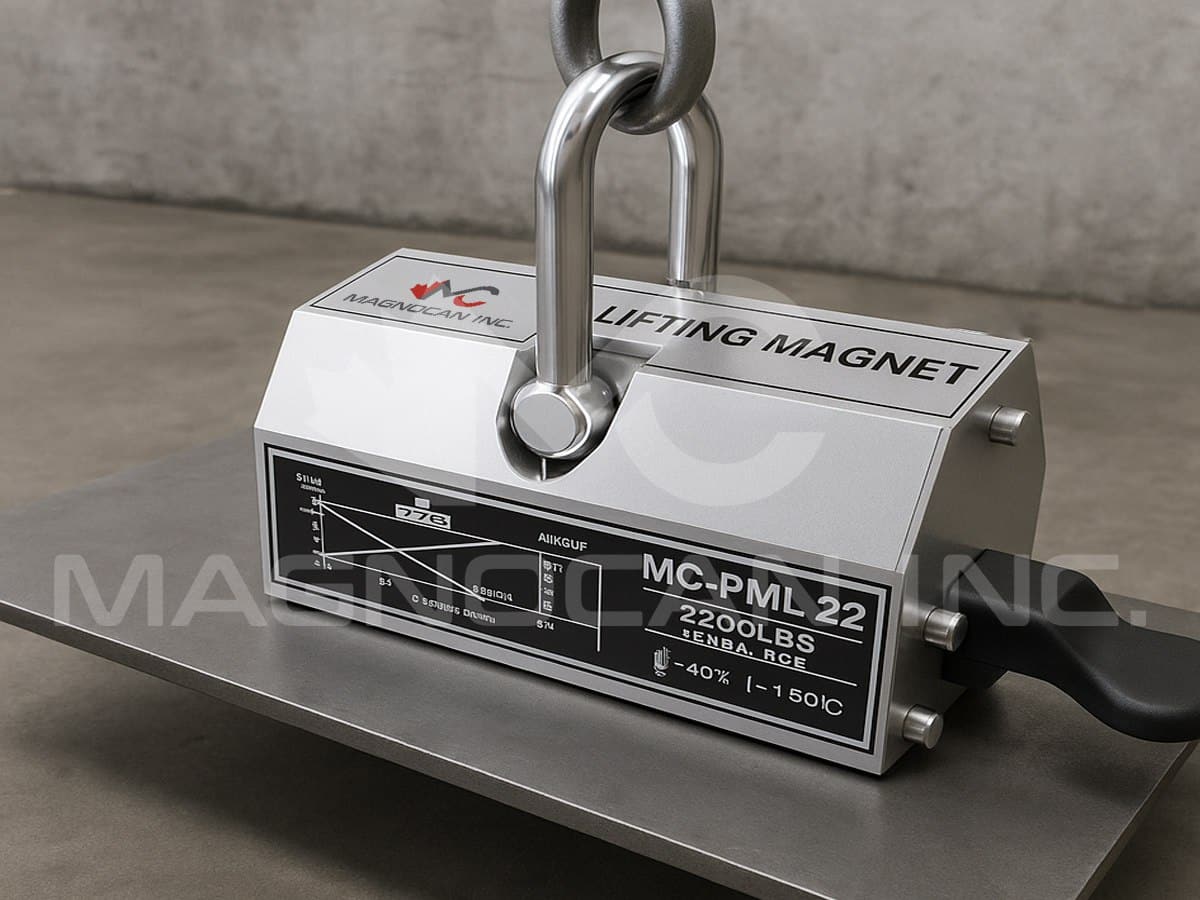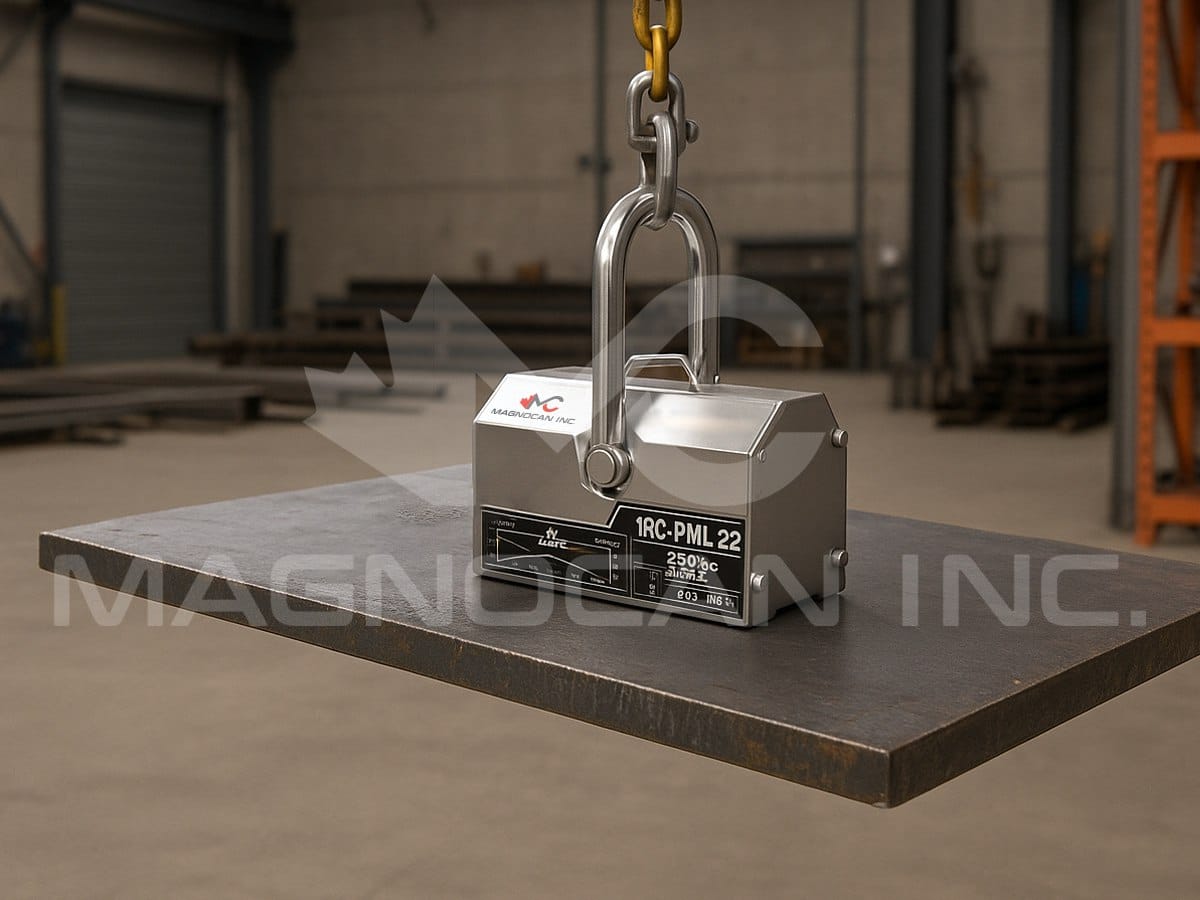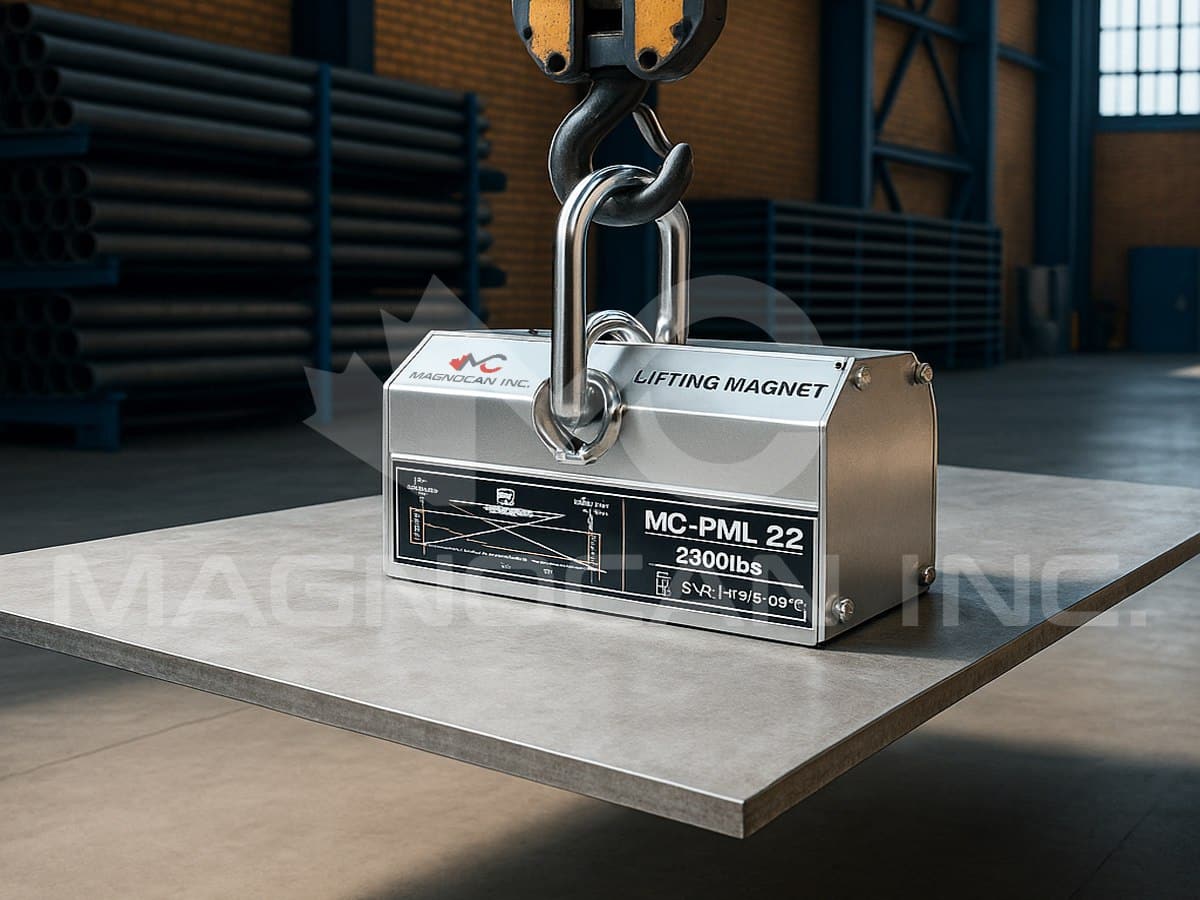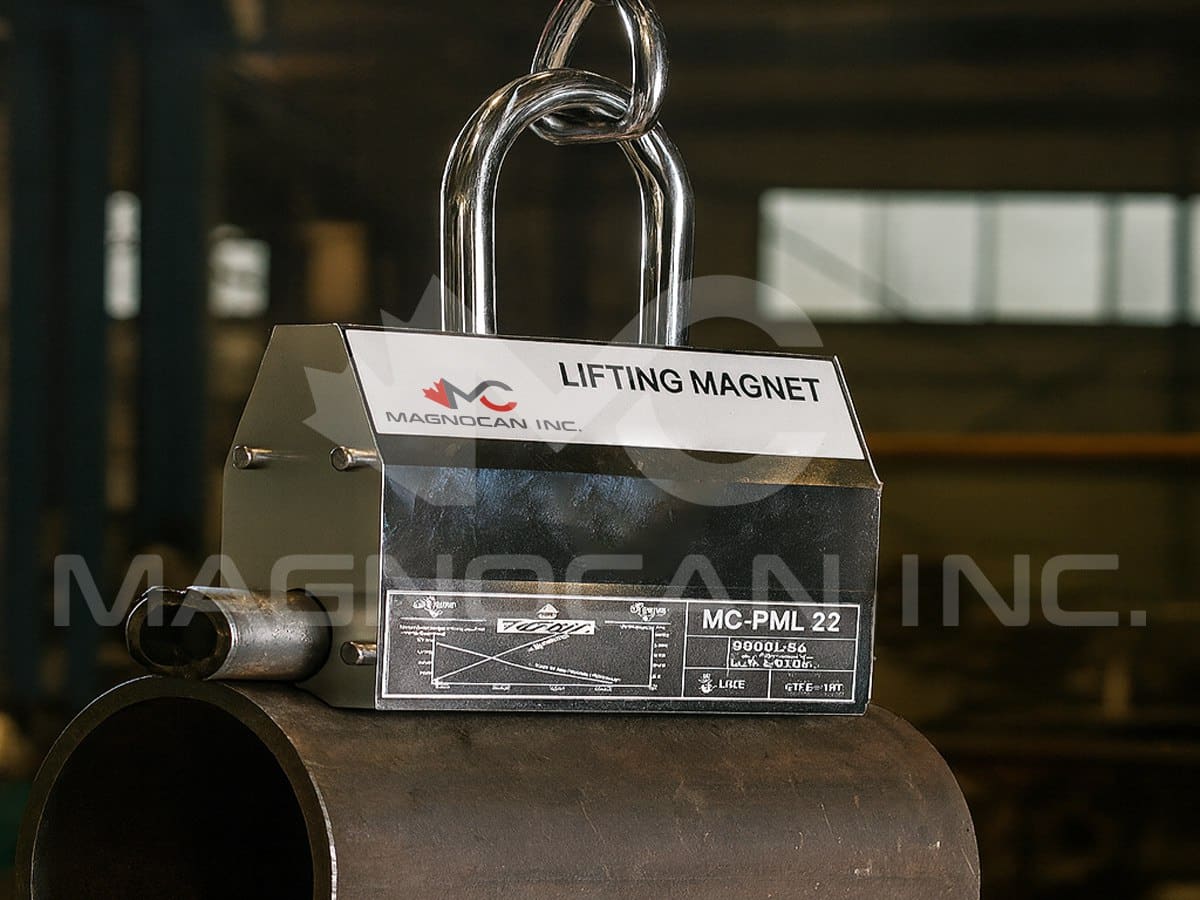A lifting magnet, also called a magnetic lifter, is an industrial device designed to lift and move ferrous metal materials — such as steel plates, rods, pipes, or scrap — using the power of magnetism. Unlike traditional lifting tools that require chains, hooks, or slings, a lifting magnet creates a direct magnetic connection between the lifter and the metal surface, enabling smooth, contact-free lifting.
If you are new to magnetic handling equipment, you may also wonder, what are industrial magnets?
— these are powerful magnetic tools used in various sectors such as mining, recycling, and manufacturing, and lifting magnets are one of the most common examples.
There are two main types of lifting magnets based on their working mechanism:

These use high-strength permanent magnets (usually made from rare-earth materials like neodymium) to create a constant magnetic field. They don’t require any external power supply and are widely used in workshops, warehouses, and metal fabrication industries for lifting flat or round ferrous objects. Permanent magnets are known for their simplicity, reliability, and zero energy consumption.
Electromagnetic lifting magnets:
These magnets generate their magnetic field only when electric current flows through their coils. Once the power is turned off, the magnetic force disappears, instantly releasing the load. Electromagnets are ideal for heavy-duty or automated operations, such as steel mills, shipyards, and scrap handling plants, where control and precision are essential.
In both types, the core principle is the same: the magnetic field lines penetrate the metal surface, aligning the electrons within the ferrous material and creating a strong attractive force that securely holds the load in place. When properly applied, this technology minimizes manual effort, reduces operational time, and greatly enhances workplace safety.
Overall, a lifting magnet is one of the most efficient and cost-effective tools in material handling. It provides a clean, reliable, and fast method to move metallic objects, making it an indispensable part of modern industries where speed, safety, and precision matter.
How Does a Lifting Magnet Work?
A lifting magnet works by generating a magnetic field that penetrates ferrous materials such as steel, iron, or cast iron, creating a strong attractive force between the magnet and the object. This magnetic field aligns the magnetic domains (tiny electron spins) inside the metal, producing a powerful magnetic bond that allows the lifter to hold, move, or release heavy metallic loads safely and efficiently.
Although different types of lifting magnets exist, all operate on the same basic principle — converting magnetic energy into mechanical lifting power.
Permanent Lifting Magnet Working Principle
A permanent lifting magnet uses strong rare-earth magnets such as neodymium (NdFeB) or samarium-cobalt (SmCo) to generate a continuous magnetic field without any external power.
Inside the magnet’s body, a rotor system or lever handle controls the magnetic circuit:
- When switched ON, the internal magnets align with the magnetic path, allowing the magnetic flux to flow through the pole pieces and into the steel load. This creates an instant and firm magnetic grip.
- When switched OFF, the rotor turns and misaligns the magnets, breaking the magnetic path and releasing the object immediately.
- This mechanical system ensures complete safety, zero energy consumption, and simple operation — making permanent lifters ideal for fabrication shops, machine parts, and metal storage warehouses.
Electromagnetic Lifting Magnet Working Principle
An electromagnetic lifting magnet uses an electrical coil (usually copper or aluminum wire) wound around a ferromagnetic core. When current passes through the coil, it produces a magnetic field that magnetizes the core and pulls the steel object toward it.
Once the power supply is stopped, the magnetic field disappears and the object is released.
This type of system is commonly found in:
- Heavy-duty industrial cranes for steel slabs, billets, and scrap
- Automated production lines where magnets are controlled by PLCs
- High-precision lifting operations requiring fast, controlled release
- Modern electromagnetic lifters are equipped with battery backup systems, fail-safe interlocks, and temperature protection, ensuring that no load is accidentally dropped during power outages or overheating.
Magnetic Field Distribution and Surface Contact
The performance of a lifting magnet largely depends on how the magnetic field lines spread across the contact surface.
Flat, clean, and thick steel plates offer maximum flux penetration, while rough or rusty surfaces interrupt the magnetic path and reduce lifting efficiency.
For this reason, regular surface cleaning, inspection, and demagnetization are essential to maintain both strength and safety.
Some designs use concentrated magnetic poles or V-shaped pole shoes to increase magnetic contact on round or irregularly shaped materials like pipes or bars.
Magnetic Traps and Magnetic Circuits
Inside both permanent and electromagnetic lifters, the magnetic circuit includes components known as magnetic traps or flux guides.
A magnetic trap is a carefully engineered part of the system that concentrates and directs magnetic flux to the desired area — usually the contact surface of the magnet.
In industrial applications, magnetic traps are also used in liquid or powder processing lines to capture unwanted metal contaminants. However, within lifting magnets, their purpose is structural: they stabilize and channel the magnetic field efficiently, ensuring maximum holding power and preventing magnetic leakage around the sides of the device.
By controlling flux paths and magnetic traps, designers can optimize the balance between lifting force, safety, and energy efficiency.
Types of Lifting Magnets Comparison Table
Lifting magnets are designed in various types and configurations to handle different materials, shapes, weights, and operating environments. The selection of the right lifting magnet depends on several factors such as load capacity, working temperature, surface condition, power availability, and lifting frequency.
In general, all lifting magnets fall into four main categories:
permanent lifting magnets, electromagnetic lifting magnets, battery-operated lifting magnets, and hybrid/custom magnetic lifters.
| Type | Power Source | Control | Typical Use | Advantages | Limitations |
| Permanent | None | Manual lever | Small to medium loads | Simple, no power needed | Fixed magnetic force |
| Electromagnetic | External electricity | Electric switch | Heavy, continuous lifting | Adjustable force, remote control | Requires constant power |
| Battery-Operated | Rechargeable battery | Electric control | Mobile or remote lifting | Portable, power-independent | Limited battery duration |
| Hybrid/Custom | Permanent + Electric | Programmable | Specialized loads | Flexible, high precision | More expensive |
Applications of Lifting Magnets in Industry (Canada Focus)
Lifting magnets Canada are essential tools across many sectors of the country’s industrial economy, where efficiency, safety, and precision handling are key to competitiveness.
From the steel mills of Ontario to the mining and fabrication facilities of Alberta, Saskatchewan, and British Columbia, magnetic lifting systems play a vital role in improving productivity and reducing operational risks.
Below are the main industrial applications of lifting magnets in Canada and how they contribute to safer, faster, and more sustainable material handling.
1. Steel and Metal Fabrication Industry
In Canada, cities like Hamilton, Windsor, and Sault Ste. Marie are known as industrial hubs for steel production and fabrication.
Lifting magnets Canada are used extensively for moving steel plates, bars, coils, and structural beams in manufacturing plants, warehouses, and shipyards.
Key Applications:
- Handling steel sheets and coils during cutting, welding, and assembly
- Transporting metal components between machining stations
- Loading and unloading steel plates from laser cutters or CNC tables
- Assisting in the production of construction steel and machinery parts
- Using lifting magnets in Canada’s steel industry minimizes manual handling, improves workflow, and reduces the risk of workplace injuries.
2. Mining and Mineral Processing
Canada is one of the world’s leading producers of iron, nickel, copper, and gold — with major mining operations in Northern Ontario, Quebec, Alberta, and British Columbia.
In these harsh environments, lifting magnets Canada are used for equipment maintenance, spare part handling, and magnet-based separation systems.
Applications include:
- Lifting and positioning heavy ferrous components in crushers and conveyors
- Removing steel debris or tramp metal from conveyor belts (via magnetic separators and overband magnets)
- Handling wear parts and liners during plant maintenance
- Working alongside magnetic traps and drum separators in ore-processing lines
- Their robust design ensures reliability even under dusty, high-temperature, or vibration-prone mining conditions.
3. Recycling and Scrap Metal Processing
With Canada’s growing focus on sustainability and the circular economy, the recycling industry heavily relies on lifting magnets Canada.
In facilities across Toronto, Edmonton, and Vancouver, electromagnets mounted on cranes or material handlers are used to pick up, sort, and load ferrous scrap efficiently.
Applications:
- Sorting and transporting ferrous scrap metals from demolition or automotive recycling
- Loading steel scrap into furnaces and shredders
- Assisting in metal recovery operations for environmental sustainability
- Reducing manual labor and improving yard safety
- Electromagnetic systems enable precise control for fast release and sorting — making them ideal for high-volume recycling operations in Canada.
4. Construction and Infrastructure Projects
Across Canada’s fast-developing cities — from Toronto’s skyscrapers to Vancouver’s ports and Calgary’s industrial zones — lifting magnets Canada are used for steel erection, prefabricated structures, and construction logistics.
Applications:
- Lifting steel rebar, beams, and plates on construction sites
- Assisting in bridge, rail, and shipyard fabrication
- Moving formworks and molds in precast concrete production
- Improving jobsite safety by reducing the use of slings and chains
- Battery-powered and hybrid lifting magnets are especially useful in outdoor and remote Canadian construction areas where power access is limited.
5. Manufacturing and Logistics Warehouses
Lifting magnets in Canada also play an important role in manufacturing and warehousing sectors, particularly in industries such as automotive, rail, heavy equipment, and renewable energy.
Applications:
- Automated handling of steel components and subassemblies
- Integration with robotic cranes and conveyor systems
- Streamlined movement of ferrous inventory in storage yards
- Reducing forklift use and optimizing loading/unloading time
- Magnetic lifters improve operational efficiency while supporting Canada’s commitment to workplace safety and automation.
6. Renewable Energy and Shipbuilding
In Canada’s Atlantic provinces and coastal regions like Nova Scotia and Newfoundland, lifting magnets Canada are used in shipbuilding, offshore energy platforms, and wind-turbine component manufacturing.
Applications:
- Lifting steel plates and hull components in shipyards
- Handling turbine shafts, gear assemblies, and maintenance parts
- Enhancing safety during installation and servicing of offshore systems
- These industries require high-strength, corrosion-resistant magnetic systems capable of performing under marine or outdoor conditions.
Across Canada’s industrial landscape, lifting magnets Canada have become indispensable tools for safe, fast, and energy-efficient material handling.
Whether used in steel plants, mines, recycling yards, or construction projects, they help reduce manual labor, improve productivity, and support sustainability goals.
As Canada continues to invest in advanced manufacturing, automation, and green energy, the demand for reliable magnetic lifting systems will continue to grow — reinforcing their role as a cornerstone of modern Canadian industry.
FAQs
1. Where can I buy industrial lifting magnets in Canada?
You can purchase industrial lifting magnets in Canada through specialized suppliers and manufacturers that focus on material-handling equipment.
Companies such as Fitmag and Magnocan offer a full range of permanent, electromagnetic, and battery-operated lifting magnets, suitable for industries like steel fabrication, mining, recycling, and construction across Canada.
2. What types of lifting magnets are commonly used in Canadian industries?
- In Canada, the most common types of lifting magnets are:
- Permanent lifting magnets for workshops and fabrication plants
- Electromagnetic lifters for steel mills and recycling yards
- Battery-powered lifters for outdoor or remote construction sites
- Hybrid/custom systems for automation and heavy manufacturing
Each type is selected based on lifting capacity, safety requirements, and work environment.
3. Are lifting magnets safe to use in Canadian workplaces?
Yes — when used correctly, lifting magnets in Canada are extremely safe.
Most models are equipped with mechanical locks, safety levers, and load indicators.
Canadian industries also follow CSA and OSHA safety standards, requiring regular inspection, surface cleaning, and testing to prevent accidents or demagnetization.
4. What industries in Canada use lifting magnets the most?
- Lifting magnets Canada are widely used across multiple sectors:
- Steel and metal fabrication (Ontario, Quebec)
- Mining and mineral processing (Alberta, Saskatchewan, BC)
- Scrap and recycling facilities (Toronto, Edmonton, Vancouver)
- Construction and energy sectors (nationwide)
These magnets help improve safety, reduce manual handling, and boost efficiency in heavy-material operations.





